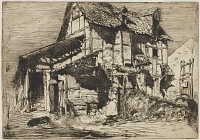Etchings Institutions search term: south kensington museum
The Unsafe Tenement | ||
| Number: | 18 | |
| Date: | 1858 | |
| Medium: | etching | |
| Size: | 158 x 226 mm | |
| Signed: | 'Whistler.' at lower right | |
| Inscribed: | 'Imp. Delatre. Rue St. Jacques. 171.' at lower left (2-3); erased (4) | |
| Set/Publication: | 'French Set', 1858 | |
| No. of States: | 4 | |
| Known impressions: | 76 | |
| Catalogues: | K.17; M.17; T.5; W.7 | |
| Impressions taken from this plate (76) | ||
TECHNIQUE
This complex composition was created in pure etching. A variety of lines were used: short, slightly undulating lines for the roof, regular cross-hatching for shadows (sometimes diagonal and sometimes vertical and horizontal shading), broken outlines, jagged rough lines for the straw, dots and dashes, and small patches of regular shading, producing a wide variety of textures, light and shadow. Extensive foul biting added textures to the ground and sky.
Horizontal lines in the sky were apparently added to the plate in the second state and then removed for the published edition by Francis Seymour Haden, Sr (1818-1910). 13

This suggests that an effect similar to Street at Saverne [14] - as reproduced above - was considered and then rejected.

This suggests that an effect similar to Street at Saverne [14] - as reproduced above - was considered and then rejected.
13: Kennedy 1910 (cat. no. 17).
PRINTING
These were followed by a limited print-run of the second state, possibly about ten impressions printed by Auguste Delâtre (1822-1907) in Paris. Impressions are in black ink on cream fibrous Japanese paper ( ; ivory chine collé (
; ivory chine collé ( ) and ivory wove paper (
) and ivory wove paper ( ); and in dark brown ink on 'antique' tan laid (
); and in dark brown ink on 'antique' tan laid ( ); cream 'modern' laid (
); cream 'modern' laid ( ); and ivory 'modern' laid paper with a partial 'RIVES' watermark (
); and ivory 'modern' laid paper with a partial 'RIVES' watermark ( ).
).
 ; ivory chine collé (
; ivory chine collé ( ) and ivory wove paper (
) and ivory wove paper ( ); and in dark brown ink on 'antique' tan laid (
); and in dark brown ink on 'antique' tan laid ( ); cream 'modern' laid (
); cream 'modern' laid ( ); and ivory 'modern' laid paper with a partial 'RIVES' watermark (
); and ivory 'modern' laid paper with a partial 'RIVES' watermark ( ).
). These were followed by around 30 impressions of the third state, almost certainly printed in London, with the active participation of both Delâtre and Francis Seymour Haden, Sr (1818-1910). Some third states were printed in dark brown ink on ivory wove paper ( ) and in black ink on grey wove (
) and in black ink on grey wove ( ) and cream Asian laid paper (
) and cream Asian laid paper ( ).
Most, however, were printed in black ink on chine collé in a wide range of shades, from ivory and cream to buff and tan, and in off-white and grey (i.e.
).
Most, however, were printed in black ink on chine collé in a wide range of shades, from ivory and cream to buff and tan, and in off-white and grey (i.e.  ,
,  ,
,  ,
,  ,
,  ,
,  ,
,  ,
,  ,
,  ,
,  ).
).
 ) and in black ink on grey wove (
) and in black ink on grey wove ( ) and cream Asian laid paper (
) and cream Asian laid paper ( ).
Most, however, were printed in black ink on chine collé in a wide range of shades, from ivory and cream to buff and tan, and in off-white and grey (i.e.
).
Most, however, were printed in black ink on chine collé in a wide range of shades, from ivory and cream to buff and tan, and in off-white and grey (i.e.  ,
,  ,
,  ,
,  ,
,  ,
,  ,
,  ,
,  ,
,  ,
,  ).
).Kennedy stated that 'Mr. W. Dowdeswell has noted that Sir Seymour Haden said at one time that he removed the sky' in the third state, and that 'Impressions in [the fourth] state are recent.' 14 These late impressions were mostly printed in black ink on Asian papers including cream Japanese paper ( ); laid paper (
); laid paper ( ,
,  ) and dark cream tissue (
) and dark cream tissue ( ) but also in dark brown ink on light-weight ivory laid western paper (
) but also in dark brown ink on light-weight ivory laid western paper ( ,
,  ).
).
 ); laid paper (
); laid paper ( ,
,  ) and dark cream tissue (
) and dark cream tissue ( ) but also in dark brown ink on light-weight ivory laid western paper (
) but also in dark brown ink on light-weight ivory laid western paper ( ,
,  ).
).14: Kennedy 1910 (cat. no. 17).
